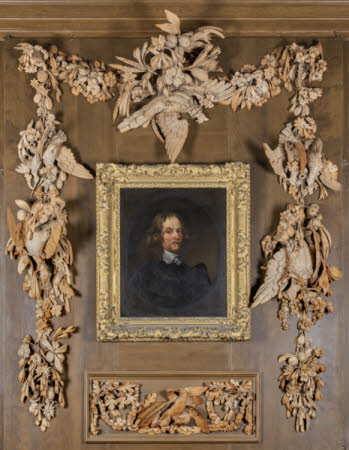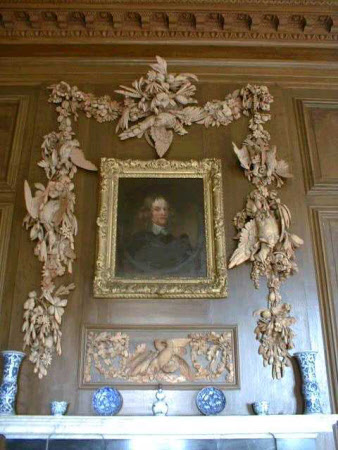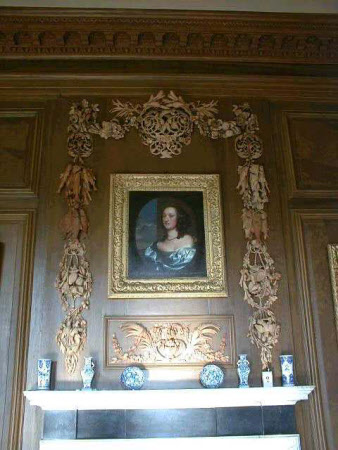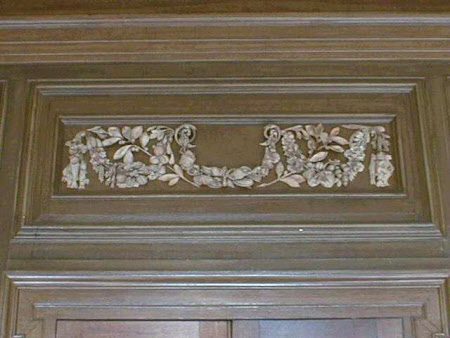Carved limewood overmantel with flowers, fruit, foliage and gamebirds
attributed to Grinling Gibbons (Rotterdam 1648 - London 1721)
Category
Art / Sculpture
Date
circa 1688
Materials
Limewood
Measurements
1500 x 1000 mm
Place of origin
England
Order this imageCollection
Belton House, Lincolnshire
NT 435033.1
Summary
Limewood, carved applique overmantel attributed to Grinling Gibbons (1648-1721), c.1688. An overmantel carved of limewood depicting game birds, foliage, flowers and fruit; comprised of two drops, central swags and cresting piece.
Full description
The central swags are crested with a spray of flowers, fruit and ears of wheat against which a dead pheasant hangs, its wings outstretched and neck feathers bristling. The drops to show dead gamevbirds including duck, pigeon, snipe or woodcock and pheasant hanging from garlands rich with fruit, flowers and foliage. Primrose, shamrock, crocus, tulip and buttercup can be seen as well as plums, pears, wheat, barley, seedpods and catkins. The overmantel was commissioned in around 1688 when the newly built Belton House was being furnished by 'Young' Sir John Brownlow (1659-97). In 1856 William Gibbs Rogers (1792-1875), a woodcarver, restorer and leading authority on Gibbons, was employed at Belton to oversee the repair and conservation of its 17th-century woodcarvings (Art Journal, 1856, vol.II, p.85 and Rogers 1866-7, pp.179-86). Rogers himself is attributed to several carvings at Belton, and worked tirelessly to preserve Gibbons’ carvings in country houses across Britain which had been ravaged by woodworm. In a letter dated 17 March 1863 to the 2nd Earl Brownlow (1842-67) Rogers refers to a carving ‘by’ Gibbons, although does not specify its location. The letter includes a copy of a letter received by Rogers from ‘G A Lowe | Clerk of the Wks’ reporting on the status of ‘the very beautiful carving by Gibbons’ at Belton House. Lowe reports: ‘I am glad to inform you that there is never any appearance of worm dust from the very beautiful carving by Gibbons since you [Rogers] preserved it years back…I should say there is not a worm in the whole of the carving, but before it was preserved I have no doubt from the appearance of various parts broken there must have been thousands. It is a very good thing the destruction is stopped so that such a beautiful piece of work may be left for years to come.’ (Brownlow Papers, Lincolnshire Archives, BNLW 2/2/3/10/12). Although no archival evidence exists to prove Gibbons’ authorship, it remains a convincing attribution (Esterley 1998, p.97). Below the overmantel is a separate limewood panel (NT 435033.3) showing doves feeding, with oak sprays, swags of phlox and arrowhead vine. This may have been brought from the mansion of Viscount Tyrconnel (1690-1754) at Arlington Street, London, where, according to the 1738 Inventory, there hung in a passage ‘A fine piece of carving in a panel by Gibbons’. Alice Rylance-Watson October 2018
Provenance
Purchased with a grant from the National Heritage Memorial Fund (NHMF) from Edward John Peregrine Cust, 7th Baron Brownlow, C. St J. (b.1936) in 1984.
Credit line
Belton House, The Brownlow Collection (acquired with the help of the National Heritage Memorial Fund by the National Trust in 1994)
Makers and roles
attributed to Grinling Gibbons (Rotterdam 1648 - London 1721), woodcarver
References
Esterly1998: David Esterly, Grinling Gibbons and the art of carving, V&A Publications, London 1998, p.97 Green 1964: David Green, Grinling Gibbons: His work as carver and statuary 1648-1721, London 1964, pp.114-5 Tipping, 1913: Henry Avray Tipping, Grinling Gibbons and the Woodwork of his Age 1648-1720, 1913, pp.185-201



